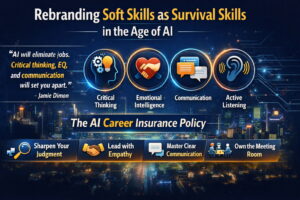
Part of an unpublished appendix for The End of Business as Usual…
Think of your favorite brand, and the first thing to come to mind is likely a logo, such as the Coca-Cola scripting, a tag-line, such as Nike’s “Just do it,” or a jingle – remember the Oscar Meyer Wiener song? These may be the aspects of a brand you remember, but they are no longer the most important aspects of branding today. Identity, persona, essence and promise, are the new kings and queens of the branding kingdom, thanks to technology and the deeper connections it opens up between brands and consumers.
Markets, consumer behavior and how businesses connect with customers are all directly impacted by technology. Looking at the rapid erosion of Blockbuster’s business model, it’s clear to see the impact that technology can have on consumer behavior. During Blockbuster’s initial bankruptcy filing, CNBC’s The Faber Report summarized it this way, “At the end of the day, this is one of those bankruptcies that’s not really about a financial situation as much as it’s about seminal changes in how people ultimately watch video.”
The increasingly important role of technology, combined with global economic unrest, means a company’s brand is more important today than it has ever been. Consumers, in search of certainty, rely heavily on a brand’s symbolism and significance. We don’t have to look much further than Netflix for a recent example of what happens when executives misread the impact of technology and consumer demand and in turn, make decisions that have negative effects on the business and the brand. In this case Reed Hastings and company raised prices, which sent customers in an uproar. Feeling the effects of negative sentiment from a full-blown PR crisis and a declining stock price, Netflix opted to divide the company into two entities, Qwikster would handle DVDs and Netflix would focus on digital and streaming. The company caved to consumer and investor pressure however and folded the two entities back under Netflix, killing off Qwikster as quickly as it introduced it. Netflix customers weren’t ready for such a bold move toward a new direction. But, any form of market research that studied conversations in social networks or quite simply, a customer engagement program would have revealed the state of consumer needs. Netflix now must focus on rebuilding its brand to earn and re-earn trust before it can take another aggressive move into the future.
Brands that fail to instill this level of confidence in consumers run the risk of falling to digital Darwinism. The brands that survive this era of economic disruption, will be the ones that are best able to evolve because they recognize the need and opportunity to do so, before their competitors .
Survival of the Fitting
Digital Darwinism is the evolution of consumer behavior when society and technology evolve faster than some companies’ ability to adapt.
The point of natural selection is that not every business will make it. As Edward Lawler and Christopher Worley note in their book Built to Change, “An analysis of Fortune 1000 corporations shows that between 1973 and 1983, 35% of companies in the top 20 were new.” Their work showed that the number of new companies rose to 45 percent between 1983 and 1993. That number increased to 60 percent between 1993 and 2003. And, as they so appropriately asked, “Any bets [as] to where it will be between 2003 and 2013?”
To further their point, a recent ad produced by Babson College cited a rather humbling statistic; “Over 40% of the companies that were at the top of the Fortune 500 in 2000 were no longer there in 2010.”
We’ve witnessed the demise of seemingly invincible brands in the U.S., such as Circuit City, Borders Books, Wherehouse, Tower Records, Pontiac, Saturn, and Palm among others. Meanwhile, grim predictions show that the pattern has no end in sight. In June, 24/7 Wall St. published its annual list of “Ten Brands That Will Disappear in 2012.” The publication predicts the demise of some of the world’s most recognizable brands, including Sony Pictures, American Apparel and Nokia.
What separates brands that falls to digital evolution from those that excel is the ability to recognize the need for change and the vision to blaze a path toward renewed relevance among a new generation of consumers.
Branding is More Important Than Ever before
In 1984, Apple stunned the world with its now iconic “1984” commercial. It firmly established Apple’s brand and ultimately set the stage for the company’s significance in the emerging personal computers market. The commercial attained legendary status, but Apple, like every brand, would still need to relentlessly compete for attention and relevance.
A year later, Apple attempted to match its previous success with “Lemmings,” a commercial that dramatized the lemming-like behavior of the PC-based workforce. The ad, while arguably brilliant, was widely considered a flop, since following the image of businessmen following one another over a cliff confused customers. Over time, Apple’s brand slowly degraded, losing touch with its core audience and missing an opportunity to connect with the growing base of consumers seeking personal computers.
When Steve Jobs returned to Apple in 1997, he was on a mission to not only turn the company he co-founded around, but also rebrand the company to connect with consumers. In a recently surfaced internal video, Jobs focused on the importance of brand as he introduced the employees to its iconic advertising campaign, “Think Different.”
“For me, marketing is about values,” said Jobs,”This is a very noisy world and we’re not going to get a chance to get people to remember much about us. So, we have to be very clear what we want them to know about us.”
The company then looked inward in an attempt to answer the questions: Who is Apple; What does it stand for and where does the brand fit in the world.
“What we’re about isn’t making boxes for people to get their jobs done,” said Jobs during the company meeting,” Apple’s core value is that we believe people with passion can change the world…for the better. Those people, crazy enough to think that they can change the world are the ones that actually do.…Here’s to the crazy ones.”
The “Think Different” campaign would run from 1997 to 2002 and effectively rebrand Apple for years to come. But that was just one example of how the company would use branding to compete for attention and relevance over the years.
Brand Empathy: Always Improve Experiences
In 2011, Millward Brown Optimor released its annual BrandZ survey that ranked and valued the world’s top brands.
Apple surged to the number one spot, soaring 84 percent relative to its 2010 ranking. The company boasts a brand value estimated at $153 billion. Google came in second, however its brand value fell by 2 percent to $111 billion. IBM came in third, with a 17-percent increase in brand value year over year to tie Google at $111 billion. McDonald’s ranked fourth, growing 23 percent and earning a brand value of $81 billion.
Any other company would likely be thrilled to be in fourth place, but not McDonald’s. The company is undergoing its most extensive store-by-store makeover in the chain’s 56-year history. Gone are the famous yellow and red interior colors. The fiberglass tables and steel chairs have also been removed. Instead, McDonald’s is adapting to a new era, creating an experience marked by muted colors, wooden tables and faux leather chairs. And, that’s just the beginning. McDonald’s is pouring $1 billion into redesigning the consumer experience. The goal is to provide create an elegant and upscale presence similar to that of Starbucks, Chipotle, and Panera Bread.
As Jim Carras, senior vice president of domestic restaurant development for McDonald’s told USA Today, “McDonald’s has to change with the times and we have to do so faster than we ever have before.”
Meanwhile, don’t expect Apple to slow down despite its newly-minted, first-place position. Apple will continue to innovate, even as the company mourns the loss of its chief visionary. Expect Apple to continue to inspire meaningful experiences, and establish a sense of unparalleled belonging. This is the charge of any brand that wants to stay at the top of the brand value list. In the face of digital Darwinism, reinvention, constant relevance, and perpetual value become the pillars for an adaptive business.
Everything begins with embracing a culture of innovation and adaptation — a culture that recognizes the impact of disruptive technology and how consumer preference and affinity is evolving. Social and mobile networks, tablets, smart phones, syndicated commerce, augmented reality, and gamification represent some of the game changers that businesses must either embrace or deeply study to determine bottom line impact. If a organizations cannot recognize opportunities to further compete for attention and relevance, it cannot, by default, create meaningful connections, a desirable brand or drive shareable experiences. The brand, as a result, will lost preference in the face of consumer choice, which may one day lead to its succumbing to digital Darwinism.
Perhaps Jobs said it best: “This is a very noisy world, so, we have to be very clear what we want them to know about us.”
I would just add…”and never stop.”
#AdaptorDie
Order The End of Business as Usual today…
Image credit: Shutterstock






Would love to hear your input on how the employment brand is facing a similar challenge
Hi Brian, wow! Was you took the words right out of my mouth-literally! Today I was thinking of writing just such a post. This is a powerful piece man! Love what you said about the seemingly invincible brands that are no more.
You hit the nail on the head as far as Apple too. But the only thing I’d add is that I think for Apple their iconic moment came even before the Mac ad in 1984. To me it goes back to the one where they through down the gauntlet and “welcomed” IBM to the playground in 81′.
At this time I was only six years old but I can still vividly remember that this the time of my first encounter with an Apple product. I begged my parents for years to get the Apple II and finally in 85 I got my first Apple product-the Apple IIc!
Nonetheless, that 84 Mac ad was iconic because it served notice to the non-tech world that Apple was about to turn the home computing world upside down. And that’s exactly what Apple did.
The thing that the Mac did was make home computers accessible, friendly and even…yes, sexy. To everyone who wasn’t a techie. Up until Apple shook things up you may as well have needed a freakin’ PhD to use a computer.
With the exception of the time following Steve’s first departure Apple consistently delivered on that brand promise to empower its users to go beyond the realm of “tech” and into the world of art, simplicity and extreme usability-which by the way just so happen to be packaged into a technical within a product.
As you can probably tell (six Apple products into this thing) I’m a Mac. Thanks for the insightful piece!
I believe this may apply to individuals as well as brands: adapt or die, and do it faster than ever before.
Another thing companies may have to learn to deal with is the rise of the “A-Player” or “Rock Star” employee, at all levels. Being really, really good at something, anything, is often correlated to a certain amount of public visibility. A public, personal brand. A-Players aren’t fungible labor units!
It just gets more interesting, faster.
Great Post, I greatly enjoyed reading it!
There’s nothing to say but AMEN! Adapt or die…but man it must hurt to have to turn around and invest $1 billion!!
Here’s a question for you Brian…how would you advise a Real Estate brokerage in today’s environment? How should they adapt?
Teri, I’m speaking on this very subject in Chicago next week!
DAMN! Well I’ll be listening closely 🙂
I missed what happened here…do you have a recording of your presentation? Would LOVE to hear!
People confuse the concept of brand with branding. A brand has always been a promise – of quality, value or experience.
Branding is how that promise remains relevant as the world changes. Branding is not just marketing’s job. Branding includes decisions on how the company has to change to keep the promise meaningful. Distribution, pricing, product and ultimately message.
Brands fail when they get bogged down in making expedient branding decisions and forget what they are at their core.
Excellent post. It is on point and on time. Brands that refuse to evolve with their customers and potential customers way of thinking , shopping and behaving, should consider themselves the blackberry of brands.
Thats really awesome. Branding is not just marketing’s. Advertising of it contains choices on how the company has to modify to keep the guarantee significant. Submission, costs, product and eventually concept.
Excellent post
Identity, personality, and image are derivatives of what a brand really is: a promise to deliver value. One of the biggest challenges for most brands in the digital era is differentiating between positioning and promise-keeping. It’s easy to make sexy claims that attract attention to yourself through various media. That’s positioning. But it’s quite another thing to deliver value that lives up to the claims you’ve made at every branded touch point. Managers have to stop confusing a position with a promise. They are not the same thing. Positioning is fundamentally a marketing exercise. Delivering on a promise requires a strategic discipline that affects capital investment, operations management, research & development, and customer service. Steve Jobs understood the difference between a position and a promise. He was a master of both.
Great minds…I just wrote about this on Monday:
http://thewordchef.com/2012/03/has-your-brand-reached-its-expiration-date/ (albeit on a slightly smaller scale). The faster the world changes, the more we need to stay relevant!
Wow, extremely deep article that is well thought out. This was a fantastic piece of work and it is something that really took some time to look over. I agree that branding is more important than ever before. This is an era where people look for name brands in everything because they can find the reputation of said product or ANYTHING by looking at that brand and telling what it is. That is why, as you pointed out, commercialization of products with fancy commercials that normally we would not see are sticking in our heads. We talk a lot about this kind of stuff in class… How much brands impact us and its undeniable. People buy Macs now because of those great commericials that we saw everyday with “the guy from the movie Accepted.” There was once a time where everybody had a PC but Mac changed its branding and look how it worked out?
Thats the beautiful thing in general about all of this stuff. Companies are now also more responsible. Once your company is a brand name and bad news comes out… watch out. Its not just mouth to mouth gossip anymore… its all over the internet, and other social media sites. In this age, you have to be extra careful!
Good article!
Hello my friend! I want to say that this article is awesome, nice written and include almost all vital info. I would like to see more posts like this.
This post couldn’t have been better-timed. I was literally just thinking about “evolutionary marketing” in terms of what makes a company thrive in a changing market, and what causes a company to go into extinction. I love what you have to offer about Apple, McDonalds, and (on the other end of things) Netflix. Recently, I looked at the difference between the (successful) evolving nature of Pop-Tarts and the (unsuccessful) failure-to-evolve-problem of Kodak. The term “Digital Darwinism” is an apt phrase to apply to our current branding climate. As always, Brian, these insights are much-appreciated.